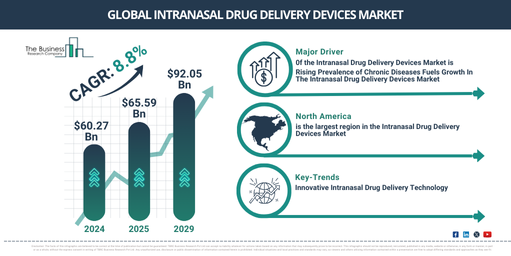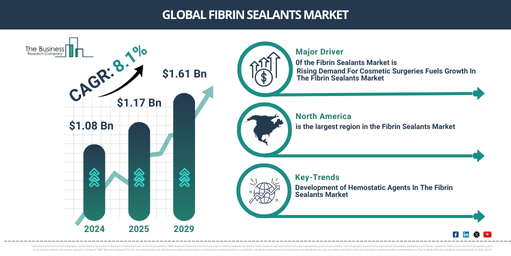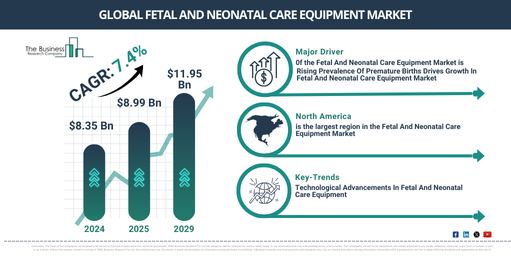Growth, Trends, and Opportunities in the Intranasal Drug Delivery Devices Market: Key Insights for the Next Decade
Updated 2025 Market Reports Released: Trends, Forecasts to 2034 – Early Purchase Your Competitive Edge Today!
What is the Long-Term Projected Growth Rate for the Intranasal Drug Delivery Devices Market, and What Are the Key Drivers?
In recent years, the market size for intranasal drug delivery devices has seen robust growth. The market is projected to increase from $60.27 billion in 2024 to $65.59 billion in 2025, marking a compound annual growth rate (CAGR) of 8.8%. This growth during the historical period can be credited to several factors including the uptick in chronic respiratory ailments, patient preference and adherence, ease of self-administration, usage in pediatric care, the boosted market scope in allergic rhinitis treatment, and a broader spectrum of indications.
Anticipations project a sturdy expansion of the intranasal drug delivery devices market size in the approaching years. The market is projected to augment to $92.05 billion by 2029, growing at a compound annual growth rate (CAGR) of 8.8%. This potential surge during the forecast period is believed to be due to factors such as the growing elder population, an upswing in global respiratory problems, broader applications in the field of neurological disorders, the emergence of personalized medicines, initiatives towards preventive healthcare and making forays into emerging economies. Key trends expected within the forecast period include the progression in formulation technologies, emphasis on applications in pediatric and geriatric sectors, enhancement in self-administration devices, the rise of nasal powder inhalers, and the inclusion of biologics and peptides.
What Drivers Are Shaping the Growth of the intranasal drug delivery devices Market?
The rise in chronic illnesses is anticipated to be a significant driver of the intranasal drug delivery devices market’s growth. These diseases are characterized by their long-term nature, requiring consistent medical care and often impacting daily activities. Intranasal drug delivery devices offer an effective, non-invasive method for managing these conditions, allowing for medication to be delivered directly to the affected region. This straightforward approach encourages quick absorption and ease of use. For instance, as per UK’s National Health Service, in June 2024, the number of individuals in England at risk of developing type 2 diabetes had increased by almost 20% from 2022, reaching over 3.6 million. Hence, growing chronic disease prevalence supports the intranasal drug delivery devices market expansion. One of the key drivers behind the intranasal drug delivery devices market’s growth is the surge in the need for non-invasive drug delivery. This approach involves delivering medicine into the body without piercing or cutting the skin or mucous membranes. Utilizing intranasal drug delivery devices makes the drug administration process simple and efficient, leveraging the large nasal blood vessel network for rapid absorption. This enhances drug bioavailability and patient compliance while minimizing application of invasive procedures. The American society for aesthetic plastic surgery reported a significant increase in non-surgical procedures like body contouring, skin treatment, toxins, and micro needing in the US in August 2023, with growth rates of 31%, 26%, 24%, and 23% respectively in 2022. As a result, the escalating demand for non-invasive drug delivery techniques fuels the growth of the intranasal drug delivery device market.
Get Your Free Sample of the Global Intranasal Drug Delivery Devices Market Report Now!
https://www.thebusinessresearchcompany.com/sample.aspx?id=13463&type=smp
Which Companies Are Leading the Charge in Expanding the Intranasal Drug Delivery Devices Market?
Major companies operating in the intranasal drug delivery devices market report are:
• Johnson and Johnson Inc._x000D_
• Merck and Co.Inc._x000D_
• Novartis AG_x000D_
• AstraZeneca plc._x000D_
• GlaxoSmithKline PLC_x000D_
What New Trends Are Reshaping the Intranasal Drug Delivery Devices Market and Its Opportunities?
Leading pharmaceutical firms in the nasal drug delivery technology market are focusing on coming up with innovative and enhanced products to offer their clientele alternative routes of drug administration, thus maintaining their market stronghold. One such example occurred in January 2023, when AptarGroup, Inc., a pharmaceutical and drug delivery business based in the US, introduced the first metal-free, recyclable, multidose nasal spray, APF Futurity. This was specifically designed to administer nasal saline and other similar over-the-counter (OTC) formulations. The APF Futurity spray, made from polyolefin materials, excludes any metallic elements or recycling disruptors, thereby eliminating the necessity for separation in recycling flows and encouraging a higher quality of recycled materials. The standout feature of this product is the design for recycling; it’s an highly recyclable nasal spray pump, with a Class AA recycling streams certification from cyclos-HTP in Europe.
Get Instant Access to the Global Intranasal Drug Delivery Devices Market Report with Swift Delivery!
What Major Market Segments Define the Scope and Growth of the Intranasal Drug Delivery Devices Market?
The intranasal drug delivery devices market covered in this report is segmented –
1) By Product: Powder Delivery Device, Liquid Delivery Device, Pressurized Metered-Dose Inhalers, Other Products
2) By Dosage: Unit-Dose, Multi-Dose
3) By Application: Chronic Obstructive Pulmonary Disease (COPD), Rhinitis, Cystic Fibrosis, Nasal Congestion, Asthma, Other Applications
4) By End User: Hospitals, Clinics, Homecare, Other End Users
Subsegments:
1) By Powder Delivery Device: Single-Dose Powder Device, Multi-Dose Powder Device
2) By Liquid Delivery Device: Single-Dose Liquid Device, Multi-Dose Liquid Device
3) By Pressurized Metered-Dose Inhalers (pMDIs): Breath-Actuated PMDIs, Conventional pMDIs
4) By Other Products: Gel Delivery Device, Nebulizers, Nasal Sprays
What Are the Top Regions Fueling Growth in the Intranasal Drug Delivery Devices Market?
North America was the largest region in the intranasal drug delivery devices market in 2024. The regions covered in the intranasal drug delivery devices market report are Asia-Pacific, Western Europe, Eastern Europe, North America, South America, Middle East, Africa.
What Are the Defining Features of the Intranasal Drug Delivery Devices Market?
Intranasal drug delivery devices are medical devices that deliver medications into the nasal cavity. These devices are intended to administer medications directly to the nasal mucosa, which is highly vascularized and has a huge surface area, allowing the drug to be absorbed into the bloodstream quickly. It delivers drugs or therapeutic substances in various forms, including sprays, powders, or liquid solutions, directly into the nasal cavity.
Browse Through More Similar Reports By The Business Research Company:
ENT Devices Global Market Report 2024
https://www.thebusinessresearchcompany.com/report/ent-devices-global-market-report
Fetal And Neonatal Monitoring Devices Global Market Report 2024
Hematology Diagnostic Devices And Equipment Global Market Report 2024
About The Business Research Company:
With over 15000+ reports from 27 industries covering 60+ geographies, The Business Research Company has built a reputation for offering comprehensive, data-rich research and insights. Armed with 1,500,000 datasets, the optimistic contribution of in-depth secondary research, and unique insights from industry leaders, you can get the information you need to stay ahead in the game.
Contact us at:
The Business Research Company: https://www.thebusinessresearchcompany.com/
Americas +1 3156230293
Asia +44 2071930708
Europe +44 2071930708
Email us at info@tbrc.info
Follow us on:
LinkedIn: https://in.linkedin.com/company/the-business-research-company
YouTube: https://www.youtube.com/channel/UC24_fI0rV8cR5DxlCpgmyFQ
Global Market Model: https://www.thebusinessresearchcompany.com/global-market-model
Found this article helpful? Share it on:



